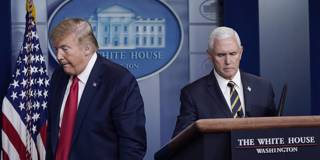Although the US mobilization for war in the 1940s seems like a close comparison to the sudden economic stop of the COVID-19 era, the two episodes have little in common. Simply put, World War II placed far greater demands on a government that was far more competent to handle them.
CAMBRIDGE – Although the COVID-19 pandemic feels unprecedented, it is not the first time that exogenous forces have radically disrupted civilian life. The most common parallel is to the American mobilization for World War II. In December 1940 – almost a year before Pearl Harbor, and as Britain stood virtually alone against Nazi aggression – US President Franklin D. Roosevelt declared, “We must be the great arsenal of democracy.”
As it happens, the first comprehensive account of America’s industrial mobilization for war, The Struggle for Survival, was written by my father, Eliot Janeway, in 1951. As a result, I grew up with a certain inherited – and subsequently augmented – knowledge of the political economy of the period, which involved a deeply complex interaction between production logistics, the political expression of competing public- and private-sector interests, and the problematic emergence of effective managers and management techniques.
The first lesson from the historical literature on this era is that the challenges we face today are fundamentally different from those of the WWII generation, with the only common element being the forced shutdown of the civilian economy. The conversion of the United States’ economy to all-out military production came just as the long, haphazard recovery from the Great Depression was finally taking root. But after 1940, civilian demand for products and services was overwhelmingly replaced by military demand.

CAMBRIDGE – Although the COVID-19 pandemic feels unprecedented, it is not the first time that exogenous forces have radically disrupted civilian life. The most common parallel is to the American mobilization for World War II. In December 1940 – almost a year before Pearl Harbor, and as Britain stood virtually alone against Nazi aggression – US President Franklin D. Roosevelt declared, “We must be the great arsenal of democracy.”
As it happens, the first comprehensive account of America’s industrial mobilization for war, The Struggle for Survival, was written by my father, Eliot Janeway, in 1951. As a result, I grew up with a certain inherited – and subsequently augmented – knowledge of the political economy of the period, which involved a deeply complex interaction between production logistics, the political expression of competing public- and private-sector interests, and the problematic emergence of effective managers and management techniques.
The first lesson from the historical literature on this era is that the challenges we face today are fundamentally different from those of the WWII generation, with the only common element being the forced shutdown of the civilian economy. The conversion of the United States’ economy to all-out military production came just as the long, haphazard recovery from the Great Depression was finally taking root. But after 1940, civilian demand for products and services was overwhelmingly replaced by military demand.